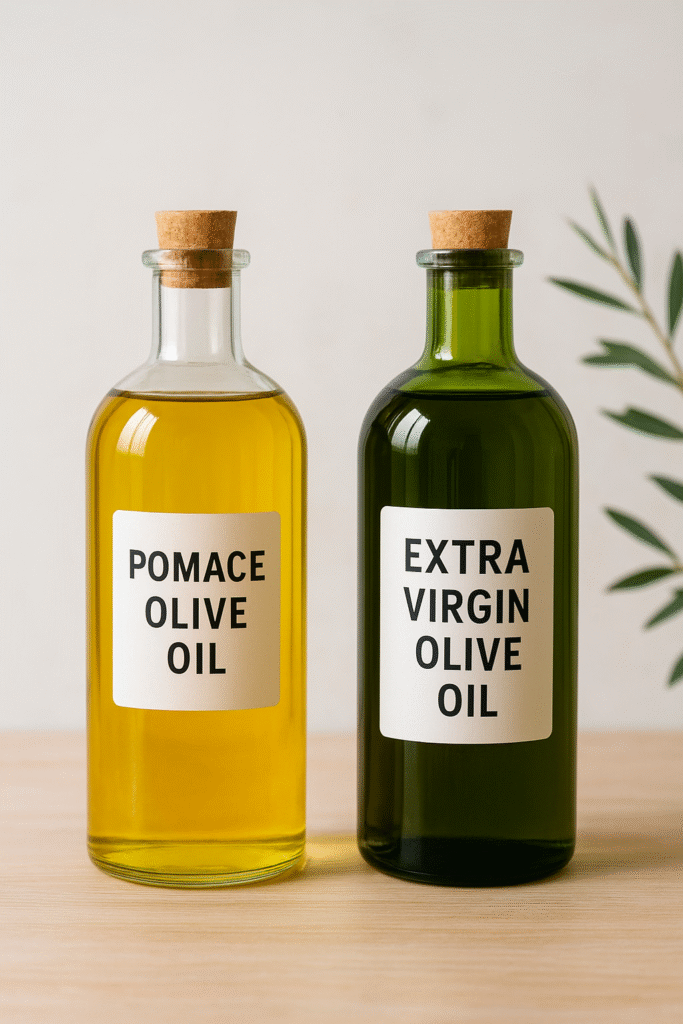If you’ve ever seen olive pomace oil sitting next to extra virgin olive oil on the supermarket shelf often at half the price you’ve probably wondered:
is this refined olive oil good for health
Is this a smart buy or a shortcut that could affect my health?
A few years ago, I asked the same question. I thought all olive oils were healthy after all, they come from the same fruit, right? But the truth is, the way the oil is extracted changes everything: the taste, the nutrients, and even its safety.
Let’s uncover the real story behind this refined olive how it’s made, whether it’s safe, and if it deserves a place in your kitchen.
Table of Contents
What Is Pomace Olive Oil?
According to the International Olive Council, pomace olive oil is produced from the residual pulp, skins, and pits left after the first cold pressing.
To understand this oil, you first need to know how regular olive oil is made. After olives are pressed for the first time, the golden liquid that flows out is Extra Virgin Olive Oil (EVOO) — the purest, most flavorful, and most nutrient-rich form.
But after that first press, what’s left behind is a solid residue made up of olive skins, pulp, and pits — known as the olive pomace. Even after pressing, a small amount of oil remains trapped in that pomace.
That’s where pomace olive oil comes from.
To extract it, producers use heat and food-grade solvents (like hexane) to draw out the remaining oil. The oil is then refined, deodorized, and often blended with a small amount of virgin olive oil to enhance color and flavor.
In short: Pomace olive oil is a refined oil made from the leftovers of the olive fruit — not cold-pressed, and not naturally extracted.
How Pomace Oil Differs from Extra Virgin Olive Oil

| Feature | Pomace Olive Oil | Extra Virgin Olive Oil (EVOO) |
|---|---|---|
| Source | Extracted from the leftover olive pulp after first pressing | Extracted from the first cold-pressing of fresh olives |
| Extraction Method | Uses solvents and heat to extract remaining oil | Cold-pressed without chemicals or heat |
| Purity | Refined and mixed with a small amount of virgin olive oil | 100% pure and unrefined |
| Flavor | Mild and neutral | Rich, fruity, and slightly peppery |
| Nutritional Value | Lower in antioxidants and polyphenols | High in antioxidants, vitamins, and healthy fats |
| Smoke Point | Higher (~240°C) — great for deep frying | Lower (~190°C) — best for salads and light sautéing |
| Color | Pale yellow | Deep green to golden hue |
| Price | More affordable | More expensive due to purity and quality |
Is Pomace Olive Oil Safe?
The safety of pomace olive oil depends heavily on how it’s produced. During high-heat extraction, compounds called polycyclic aromatic hydrocarbons (PAHs) including benzopyrene — may form. These are considered carcinogenic (cancer-causing) if present in large amounts.
However, modern, high-quality producers follow strict IOC (International Olive Council) standards, which require benzopyrene levels to remain below 2 µg/kg. When processed properly, pomace oil is safe for consumption
The concern arises mainly in regions where standards are not enforced. For example, some cheap pomace oils in markets like India or the U.S. may not meet IOC safety criteria. That’s why it’s important to buy from reputable brands that adhere to global food safety norms.
External Link Suggestion: Learn more about IOC olive oil standards
The 2001 Pomace Oil Controversy
In 2001, the Spanish government discovered high levels of PAHs in several brands of pomace olive oil and immediately banned their sale. The UK Food Standards Agency (FSA) also pulled similar products from store shelves.
Later investigations found that not all pomace oils were affected, and improved production methods were introduced. The ban was lifted, but the incident remains a reminder that quality control matters when it comes to refined oils.
Can You Cook with Pomace Olive Oil?
Absolutely. Pomace olive oil has a higher smoke point (around 230°C), making it suitable for deep-frying, roasting, and high-heat cooking. It doesn’t break down or release harmful compounds as easily as some other vegetable oils.
According to Healthline, pomace olive oil’s high smoke point makes it suitable for frying, roasting, and sautéing.
Many restaurants use pomace olive oil for frying because it’s affordable and stable. However, it lacks the flavor and nutritional richness of extra virgin olive oil, so it’s not ideal for salads or drizzling over food.
Nutritional Facts (Per 100ml)
Calories: ~884 kcal
Total Fat: 100g
Monounsaturated Fat: 73g
Saturated Fat: 14g
Polyunsaturated Fat: 11g
Vitamin E: 14mg (reduced compared to extra virgin)
Zero carbohydrates or protein
Fun Facts About Pomace Olive Oil
Spain and Italy produce over 90% of the world’s pomace olive oil.
Pomace oil is also used in cosmetics, soaps, and biofuels.
Refined pomace oil has a longer shelf life due to lower natural enzymes.
Its neutral flavor makes it a favorite for commercial cooking and baking.
Extended FAQ: Common Questions About Pomace Olive Oil
Is Pomace Olive Oil Real Olive Oil?
Technically, yes it’s extracted from the olive fruit. However, because it’s obtained using heat and chemicals, it’s not considered “real” olive oil in terms of quality.
2. Can Pomace Olive Oil Cause Cancer?
Only if it contains unsafe levels of PAHs. Reputable brands follow IOC limits, keeping it safe. Always check for certifications or “IOC approved” labeling.
3. Is Pomace Olive Oil Good for Frying?
Yes, it’s excellent for high-heat cooking due to its higher smoke point and stability.
4. Can Pomace Olive Oil Be Used for Skin and Hair?
Yes! It’s used in cosmetic industries for its moisturizing properties. It’s affordable and non-sticky, making it great for skincare and massage oils.
5. Does Pomace Olive Oil Contain Cholesterol?
No, all plant-based oils, including pomace olive oil, are cholesterol-free. It may help maintain good HDL cholesterol when used moderately.
6. Which Olive Oil Is Best for Health?
Extra virgin olive oil is best for health because it’s unrefined, antioxidant-rich, and anti-inflammatory.
7. Can I Mix Pomace Olive Oil with Extra Virgin?
Yes, you can mix them to balance flavor, cost, and smoke point ideal for daily cooking.
8.How Do I Know If My Pomace Olive Oil Is Pure?
In the United States, look for labels that clearly say “Refined Pomace Olive Oil” or “Olive Pomace Oil – Refined and Blended”.
Genuine pomace oil should include the words “Refined” because it undergoes a heating and purification process.
Check for quality certifications from recognized authorities such as:
USDA (U.S. Department of Agriculture) — ensures food labeling accuracy and purity.
FDA (Food and Drug Administration) — oversees food safety and quality compliance.
California Olive Oil Council (COOC) — applies stricter testing for authenticity and purity, especially for oils sold in California.
North American Olive Oil Association (NAOOA) — certifies olive oils that meet international quality and purity standards.
Avoid unbranded, imported oils with vague or missing origin details. Choose reputable brands that disclose:
Country of origin and bottling (e.g., “Product of Spain, Packed in the USA”).
Lot number or batch tracking information.
Best-before date (ideally within 18–24 months of production).
In short: Transparent labeling + trusted certification = real, safe pomace olive oil.
9. Is Pomace Olive Oil Vegan and Gluten-Free?
Yes it’s 100% plant-based, vegan-friendly, and naturally gluten-free.
10. Can Pomace Olive Oil Go Bad?
Yes, like all oils, it can go rancid over time. Store it in a cool, dark place, away from direct sunlight. It usually lasts about 18–24 months unopened.
🌿 Final Thoughts
Pomace olive oil is a practical, budget-friendly option for cooking, especially for high-heat use. But it’s not a substitute for the rich taste and health benefits of extra virgin olive oil.
Watch this short video to learn more about how pomace olive oil is processed on YouTube.
If you cook often and need a neutral, heat-stable oil pomace is fine. But for salads, dressings, or when you want maximum nutrition, go with extra virgin olive oil.
Ultimately, knowing the difference helps you make smarter choices for your kitchen and your health.
Remember: Not all olive oils are created equal. Choose wisely, cook consciously, and enjoy the best of both worlds.







Leave a Reply